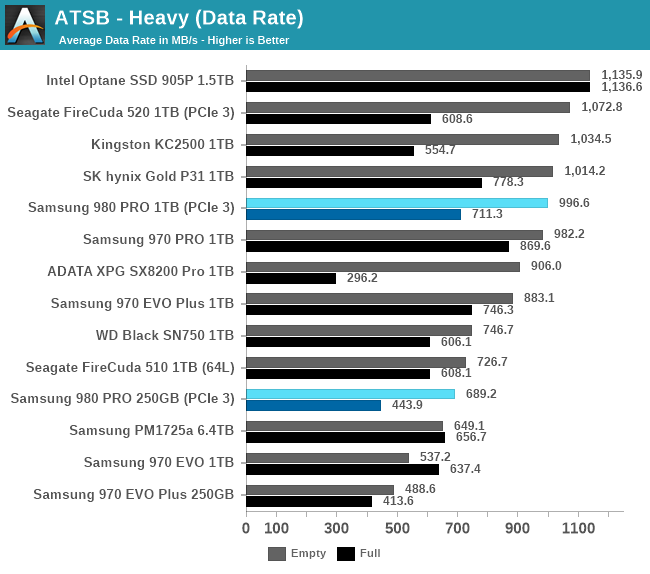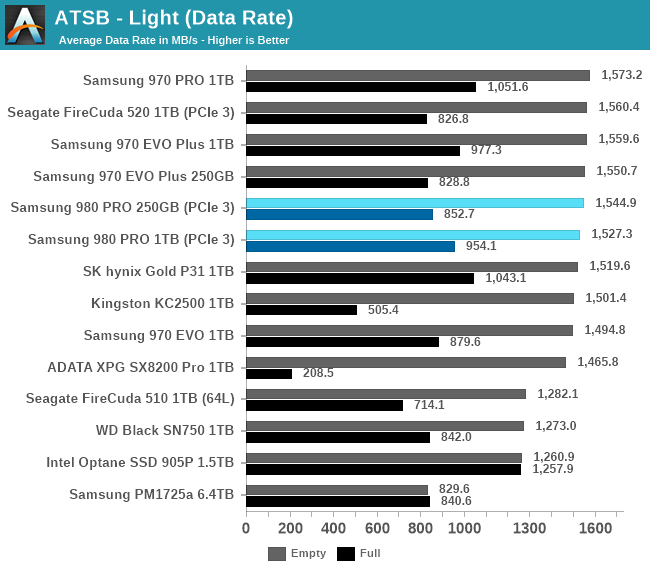The Samsung 980 PRO PCIe 4.0 SSD Review: A Spirit of Hope
by Billy Tallis on September 22, 2020 11:20 AM ESTNote: Our SSD testbed is currently producing suspiciously slow scores for The Destroyer, so those results have been omitted pending further investigation.
Note2: We are currently in the process of testing these benchmarks in PCIe 4.0 mode. Results will be added as they finish.
AnandTech Storage Bench - Heavy
Our Heavy storage benchmark is proportionally more write-heavy than The Destroyer, but much shorter overall. The total writes in the Heavy test aren't enough to fill the drive, so performance never drops down to steady state. This test is far more representative of a power user's day to day usage, and is heavily influenced by the drive's peak performance. The Heavy workload test details can be found here. This test is run twice, once on a freshly erased drive and once after filling the drive with sequential writes.
 |
|||||||||
| Average Data Rate | |||||||||
| Average Latency | Average Read Latency | Average Write Latency | |||||||
| 99th Percentile Latency | 99th Percentile Read Latency | 99th Percentile Write Latency | |||||||
| Energy Usage | |||||||||
The 250GB Samsung 980 PRO is a clear improvement across the board relative to the 970 EVO Plus. It still has some fairly high latency scores, especially for the full drive test run, but that's to be expected for this capacity class. The 1TB model seems to have sacrificed a bit of its full drive performance for in favor of a slight increase in empty-drive performance—the enlarged SLC caches are probably a contributing factor here.
Both drives show a significant reduction in energy usage compared to the older generation of Samsung M.2 NVMe drives, but there's still a ways to go before Samsung catches up to the most efficient 8-channel drives.
AnandTech Storage Bench - Light
Our Light storage test has relatively more sequential accesses and lower queue depths than The Destroyer or the Heavy test, and it's by far the shortest test overall. It's based largely on applications that aren't highly dependent on storage performance, so this is a test more of application launch times and file load times. This test can be seen as the sum of all the little delays in daily usage, but with the idle times trimmed to 25ms it takes less than half an hour to run. Details of the Light test can be found here. As with the ATSB Heavy test, this test is run with the drive both freshly erased and empty, and after filling the drive with sequential writes.
 |
|||||||||
| Average Data Rate | |||||||||
| Average Latency | Average Read Latency | Average Write Latency | |||||||
| 99th Percentile Latency | 99th Percentile Read Latency | 99th Percentile Write Latency | |||||||
| Energy Usage | |||||||||
The Samsung 980 PRO does not bring any significant improvements to performance on the Light test. Peak performance from most high-end NVMe drives is essentially the same, and the only meaningful differences are on the full-drive test runs. Aside from a relatively high 99th percentile write latency from the 250GB 980 PRO, neither capacity has any trouble with the full-drive test run.
Samsung has made significant improvements to energy efficiency with the 980 PRO. Samsung's previous generation of M.2 NVMe drives were among the most power-hungry in this segment, with their performance potential largely wasted on such a light workload. The 980 PRO cuts energy usage by a third compared to the 970 generation drives, bringing them more into competition with other high-end M.2 drives. But as with the Heavy test, there's still a lot of room for improvement as illustrated by drives like the WD Black SN750.










137 Comments
View All Comments
jeremyshaw - Tuesday, September 22, 2020 - link
Given how fast the TLC was when the SLC cache was exhausted (and was undoubtedly working on flushing the SLC cache into TLC), I wonder how much faster the native TLC mode of the SSD could be?Billy Tallis - Tuesday, September 22, 2020 - link
Their ISSCC 2019 presentation about the 512Gbit 128L die (which will be used in the 2TB 980 PRO) claims a write speed of 82MB/s per die. The 1TB 980 PRO is using a total of 32 of the 256Gbit dies, and if it's the same speed then that would work out to 2624 MB/s. So that suggests the total drive fill process is barely slowed down at all by the SLC caching dance, and a datacenter drive using this NAND and controller could hit almost twice the write throughput the current 960GB 983 DCT is rated for.System75 - Wednesday, September 23, 2020 - link
Why don't you test a fully filled SSD performance anymore like you used to in AnandTech Storage Bench - Heavy? An empty 980 pro drive performance is not what its target consumer wants to know.alyarb - Tuesday, September 22, 2020 - link
thanks for the memories Samsung, but I'm outnandnandnand - Tuesday, September 22, 2020 - link
Is the Spirit of Hope dead?Hyoyeon - Tuesday, September 22, 2020 - link
That SK Hynix P31 could become my new favorite drive.Hifihedgehog - Tuesday, September 22, 2020 - link
Not quite. The P31 is an amazing value, but I have yet to find a lower latency drive than a Samsung. The P31 does nip at the heels and even surprises in some tests, but it still falls massively short in many latency-sensitive situations where it is easily outclassed by the 970 EVO Plus and above. You get what you pay for.https://www.storagereview.com/review/sk-hynix-gold...
https://www.storagereview.com/review/sk-hynix-gold...
lmcd - Tuesday, September 22, 2020 - link
For laptop usage that latency is not even close to worth it. I'm optimistic the upgrade from a 970 EVO (don't worry, it's primarily for a capacity upgrade) will help my inefficient Ryzen 2700U hold on a bit longer when off the charger.MikeMurphy - Tuesday, September 22, 2020 - link
The P31 performs admirably and does so while consuming very little power and producing very little heat. It doesn't trounce the Samsung drives in every metric but at that price and power budget it doesn't have to.Samus - Wednesday, September 23, 2020 - link
If Hynix wanted to crank up the heat and power consumption, there is nothing stopping them operating the controller at a higher frequency to reduce the latency caused by processing overhead.But they realize there is no need for this at the moment as they have a product that is class-leading in a class it doesn't even compete in.